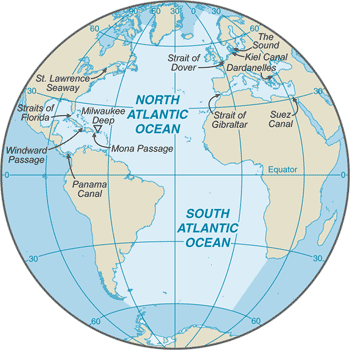
-
Introduction :: Atlantic Ocean
-
Background:The Atlantic Ocean is the second largest of the world's five oceans (after the Pacific Ocean, but larger than the Indian Ocean, Southern Ocean, and Arctic Ocean). The Kiel Canal (Germany), Oresund (Denmark-Sweden), Bosporus (Turkey), Strait of Gibraltar (Morocco-Spain), and the Saint Lawrence Seaway (Canada-US) are important strategic access waterways.The decision by the International Hydrographic Organization in the spring of 2000 to delimit a fifth world ocean, the Southern Ocean, removed the portion of the Atlantic Ocean south of 60 degrees south latitude.
-
Geography :: Atlantic Ocean
-
Location:body of water between Africa, Europe, the Arctic Ocean, the Americas, and the Southern OceanGeographic coordinates:0 00 N, 25 00 WMap references:Political Map of the WorldArea:total: 76.762 million sq km
note: includes Baltic Sea, Black Sea, Caribbean Sea, Davis Strait, Denmark Strait, part of the Drake Passage, Gulf of Mexico, Labrador Sea, Mediterranean Sea, North Sea, Norwegian Sea, almost all of the Scotia Sea, and other tributary water bodies
Area - comparative:about 7.5 times the size of the USCoastline:111,866 kmClimate:tropical cyclones (hurricanes) develop off the coast of Africa near Cabo Verde and move westward into the Caribbean Sea; hurricanes can occur from May to December but are most frequent from August to NovemberTerrain:surface usually covered with sea ice in Labrador Sea, Denmark Strait, and coastal portions of the Baltic Sea from October to June; surface dominated by two large gyres (broad, circular systems of currents), one in the northern Atlantic and another in the southern Atlantic; the ocean floor is dominated by the Mid-Atlantic Ridge, a rugged north-south centerline for the entire Atlantic basin
major surface currents: clockwise North Atlantic Gyre consists of the northward flowing, warm Gulf Stream in the west, the eastward flowing North Atlantic Current in the north, the southward flowing cold Canary Current in the east, and the westward flowing North Equatorial Current in the south; the counterclockwise South Atlantic Gyre composed of the southward flowing warm Brazil Current in the west, the eastward flowing South Atlantic Current in the south, the northward flowing cold Benguela Current in the east, and the westward flowing South Equatorial Current in the north
Elevation:mean depth: -3,646 mlowest point: Milwaukee Deep in the Puerto Rico Trench -8,605 mhighest point: sea levelNatural resources:oil and gas fields, fish, marine mammals (seals and whales), sand and gravel aggregates, placer deposits, polymetallic nodules, precious stonesNatural hazards:icebergs common in Davis Strait, Denmark Strait, and the northwestern Atlantic Ocean from February to August and have been spotted as far south as Bermuda and the Madeira Islands; ships subject to superstructure icing in extreme northern Atlantic from October to May; persistent fog can be a maritime hazard from May to September; hurricanes (May to December)Environment - current issues:endangered marine species include the manatee, seals, sea lions, turtles, and whales; unsustainable exploitation of fisheries (over fishing, bottom trawling, drift net fishing, discards, catch of non-target species); pollution (maritime transport, discharges, offshore drilling, oil spills); municipal sludge pollution off eastern US, southern Brazil, and eastern Argentina; oil pollution in Caribbean Sea, Gulf of Mexico, Lake Maracaibo, Mediterranean Sea, and North Sea; industrial waste and municipal sewage pollution in Baltic Sea, North Sea, and Mediterranean SeaGeography - note:major chokepoints include the Dardanelles, Strait of Gibraltar, access to the Panama and Suez Canals; strategic straits include the Strait of Dover, Straits of Florida, Mona Passage, The Sound (Oresund), and Windward Passage; the Equator divides the Atlantic Ocean into the North Atlantic Ocean and South Atlantic Ocean -
Government :: Atlantic Ocean
-
Country name:etymology: name derives from the Greek description of the waters beyond the Strait of Gibraltar, Atlantis thalassa, meaning "Sea of Atlas"
-
Economy :: Atlantic Ocean
-
Economy - overview:The Atlantic Ocean provides some of the world's most heavily trafficked sea routes, between and within the Eastern and Western Hemispheres. Other economic activity includes the exploitation of natural resources, e.g., fishing, dredging of aragonite sands (The Bahamas), and production of crude oil and natural gas (Caribbean Sea, Gulf of Mexico, and North Sea).Marine fisheries:
the Atlantic Ocean fisheries are the second most important in the world accounting for 25%, or 19,735,777 mt, of the global catch in 2016; of the seven regions delineated by the Food and Agriculture Organization in the Atlantic basin, the most important include the following:
Northeast Atlantic region (Region 27) is the third most important in the world producing more than 10% of the global catch or 8,313,901 mt in 2016; the region encompasses the waters north of 36º North latitude and east of 40º West longitude with the major producers including Norway (1,869,403 mt), Iceland (1,067,015 mt), Russia (1,034,743 mt), UK (695,936 mt), and Denmark (664,122 mt); the region includes the historically important fishing grounds of the North Sea, the Baltic Sea, and the Atlantic waters between Greenland, Iceland, and the British Isles; the principal catches include Atlantic cod, haddock, saithe (pollock), Blue Whiting, herring, and mackerel; not all fish caught are for human consumption, half of fish catches in the North Sea are processed as fish oil or fish meal, which are used in animal fodder
Eastern Central Atlantic region (Region 34) is the second most important Atlantic fishery, and seventh largest in the world producing 6% of the global catch or 4,795,171 mt in 2016; the region encompasses the waters between 36º North and 6º South latitude and east of 40º West longitude off the west coast of Africa with the major producers including Morocco (1,407,807 mt), Nigeria (357,099 mt), Mauritania (594,754 mt), Senegal (442,910 mt), Ghana (237,457 mt), Cameroon (205,190 mt), and Sierra Leone (200,000 mt); the principal catches include pilchard, sardinellas, shad, and mackerel
Northwest Atlantic region (Region 21) is the third most important Atlantic fishery and ninth in the world producing a little more than 2% of the global catch and 1,811,436 mt in 2016; it encompasses the waters north of 35º North latitude and west of 42º West longitude including the important fishing grounds over the continental shelf of North America such as the Grand Banks, the Georges Bank, and the Flemish Cap, as well as Baffin Bay with the major producers including the US (917,337 mt), Canada (650,950 mt), and Greenland (171,770 mt); the principal catches include sea scallops, prawns, lobster, herring, and menhaden
Mediterranean and Black Sea region (Region 37) is a minor fishing region representing 1.5% or 1,236,999 mt of the world’s total capture in 2016; the region encompasses all waters east of the Strait of Gibraltar with the major producers including Turkey (301,470 mt), Italy (188,783 mt), Tunisia (113,837 mt), Russia (99,759 mt), and Spain (78,491 mt); the principal catches include European anchovy, European pilchard, Gobies, and clams
FAO map of world fishing regions; used with permission.: PDF
PDF
-
Military and Security :: Atlantic Ocean
-
Maritime threats:West African piracy more than doubled in 2018 totaling 85 attacks, including all of the six ships highjacked during the year; 13 of the 18 vessels fired upon world-wide occurred in West African waters; Nigerian pirates are very aggresive, operating as far as 200 nm offshore and boarded 29 ships in 2018; the Maritime Administration of the US Department of Transportation has issued a Maritime Advisory (2019-010-Gulf of Guinea-Piracy/Armed Robbery/Kidnapping for Ransom) effective 19 July 2019, which states in part "Piracy, armed robbery, and kidnapping for ransom (KFR) continue to serve as significant threats to U.S. flagged vessels transiting or operating in the Gulf of Guinea (GoG). ...According to the Office of Naval Intelligence’s “Weekly Piracy Reports” 72 reported incidents of piracy and armed robbery at sea occurred in the GoG region this year as of July 9, 2019. Attacks, kidnappings for ransom (KFR), and boardings to steal valuables from the ships and crews are the most common types of incidents with approximately 75 percent of all incidents taking place off Nigeria. During the first six months of 2019, there were 15 kidnapping and 3 hijackings in the GoG."
-
Transportation :: Atlantic Ocean
-
Railways:Roadways:Ports and terminals:major seaport(s): Alexandria (Egypt), Algiers (Algeria), Antwerp (Belgium), Barcelona (Spain), Buenos Aires (Argentina), Casablanca (Morocco), Colon (Panama), Copenhagen (Denmark), Dakar (Senegal), Gdansk (Poland), Hamburg (Germany), Helsinki (Finland), Las Palmas (Canary Islands, Spain), Le Havre (France), Lisbon (Portugal), London (UK), Marseille (France), Montevideo (Uruguay), Montreal (Canada), Naples (Italy), New Orleans (US), New York (US), Oran (Algeria), Oslo (Norway), Peiraiefs or Piraeus (Greece), Rio de Janeiro (Brazil), Rotterdam (Netherlands), Saint Petersburg (Russia), Stockholm (Sweden)Transportation - note:Kiel Canal and Saint Lawrence Seaway are two important waterways; significant domestic commercial and recreational use of Intracoastal Waterway on central and south Atlantic seaboard and Gulf of Mexico coast of US; the International Maritime Bureau reports the territorial waters of littoral states and offshore Atlantic waters as high risk for piracy and armed robbery against ships, particularly in the Gulf of Guinea off West Africa; in 2014, 41 commercial vessels were attacked in the Gulf of Guinea with 5 hijacked and 144 crew members taken hostage; hijacked vessels are often disguised and cargoes stolen; crews have been robbed and stores or cargoes stolen
-
Transnational Issues :: Atlantic Ocean
-
Disputes - international:
some maritime disputes (see littoral states)